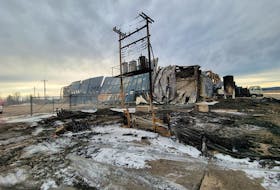ST. JOHN'S, N.L. — There’s a lot of concern dangling over the health of the Atlantic salmon stocks in the province, as there is throughout Atlantic Canada.
Hooked in are business and recreational interests, and Indigenous/subsistence landings.
Hook-and-release angling is always a topic that creates a flow of debate, as contentious and loud as the rapids on the mightiest of salmon rivers.
The year’s discussions all start with the latest scientific information.
For the public, that came Tuesday at the Department of Fisheries and Oceans (DFO) in St. John’s with the presentation of the latest stock assessment information.
As with other fish and shellfish species, a precautionary approach is used for salmon stock assessment that identifies three stock status zones (critical, cautious and healthy), sets removal rates within each zone, and adjusts removal rates according to the stock status.
DFO science notes it uses river-specific per cent conservation achieved (egg deposition) to provide consistent advice to fisheries managers.
In 2018:
• Atlantic Salmon stocks were in the critical zone on 50 per cent of assessed rivers in Labrador (two of four rivers); and 47 per cent of rivers on the island part of the province (eight of 17 rivers);
• Thirty-one per cent (five of 16) rivers showed declines in total returns, and three of these rivers had declines of greater than 30 per cent compared to the previous five to six years.
• Seventy-five per cent (12 of 16) of rivers showed declines in large salmon abundance compared to the previous five to six years.
“Slight improvements in the Atlantic salmon stocks were observed on many assessed rivers in 2018,” the report states. “However, there is still concern about salmon stocks given the unprecedented declines in 2016 and 2017. Declines of this magnitude have not been observed since the commercial salmon moratoriums in 1992 (island) and 1998 (Labrador).”
The estimated recreational catch for Atlantic salmon in 2018 was 13,600 retained and 25,000 released.
The estimated harvest from Labrador Indigenous and subsistence fisheries was 12,900.
The status of Atlantic salmon on the south coast of Newfoundland remains poor. Returns to Conne River and Little River were the lowest on record over the past 30 years.
“We are still concerned about salmon stocks due to low returns on some rivers, particularly on the south coast of Newfoundland where returns are at an historical low,” the report stated.
New research will be conducted in 2019, including tagging of salmon to better understand issues affecting survival rates at sea.
The science information will be used by fisheries managers in setting conservation measures and fishing limits this year.








